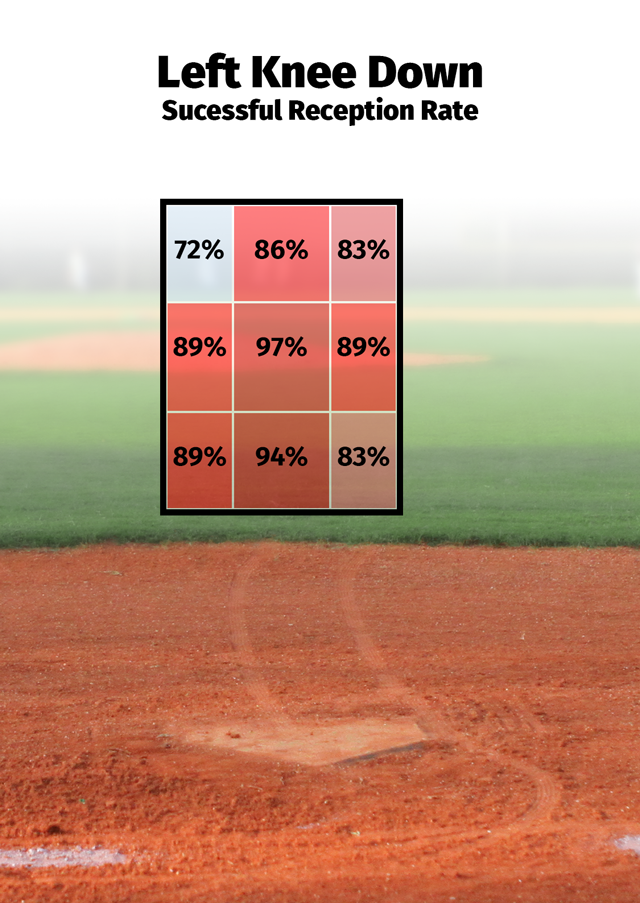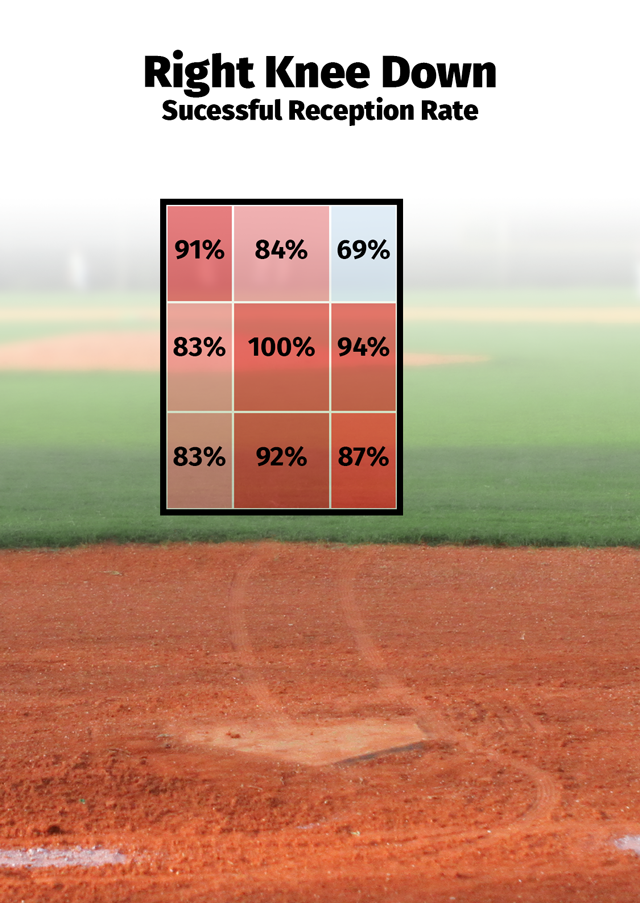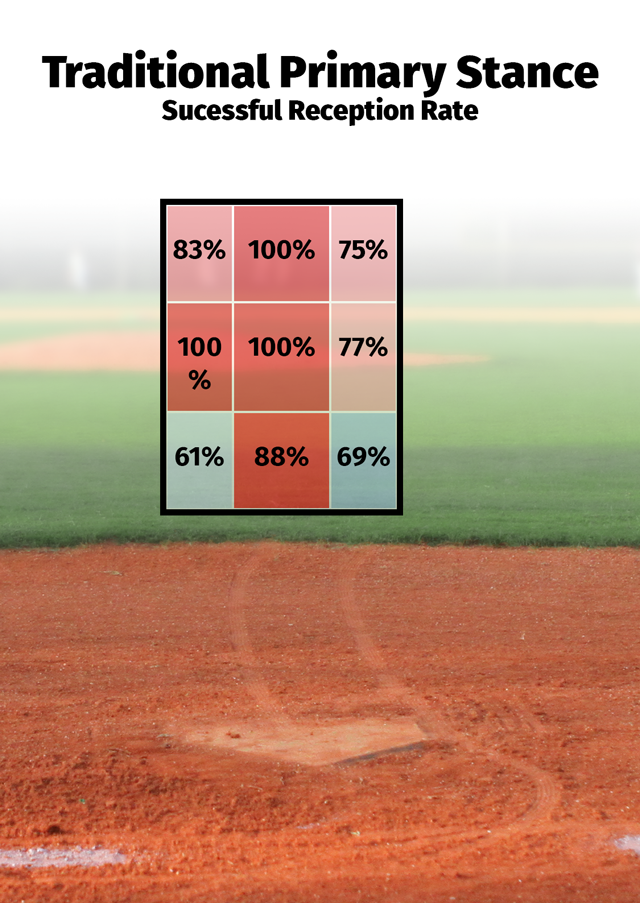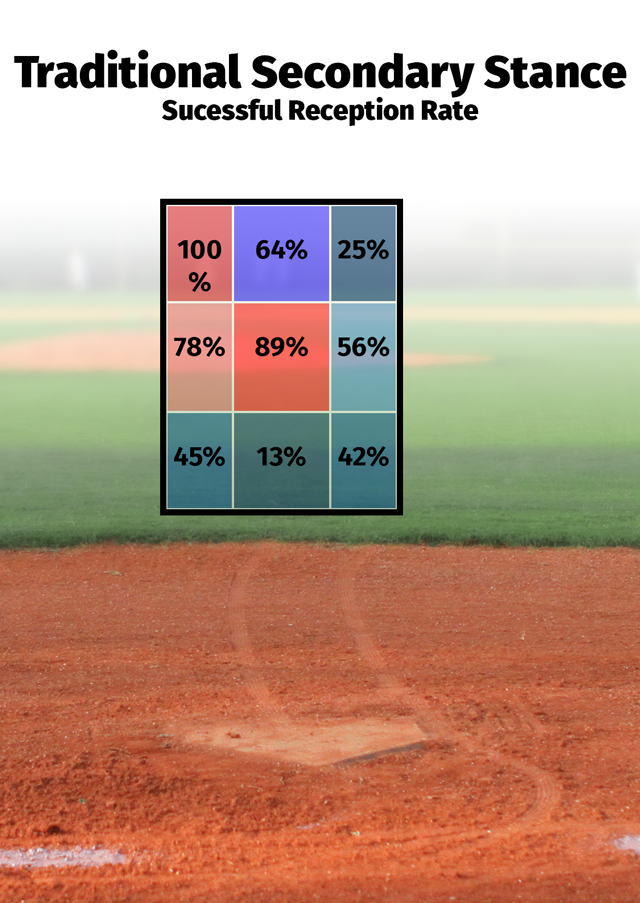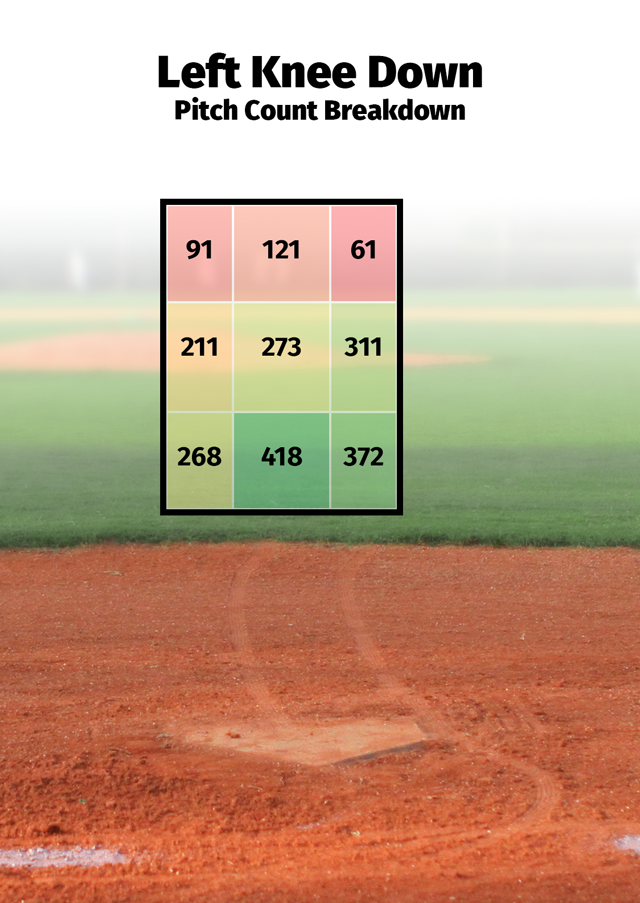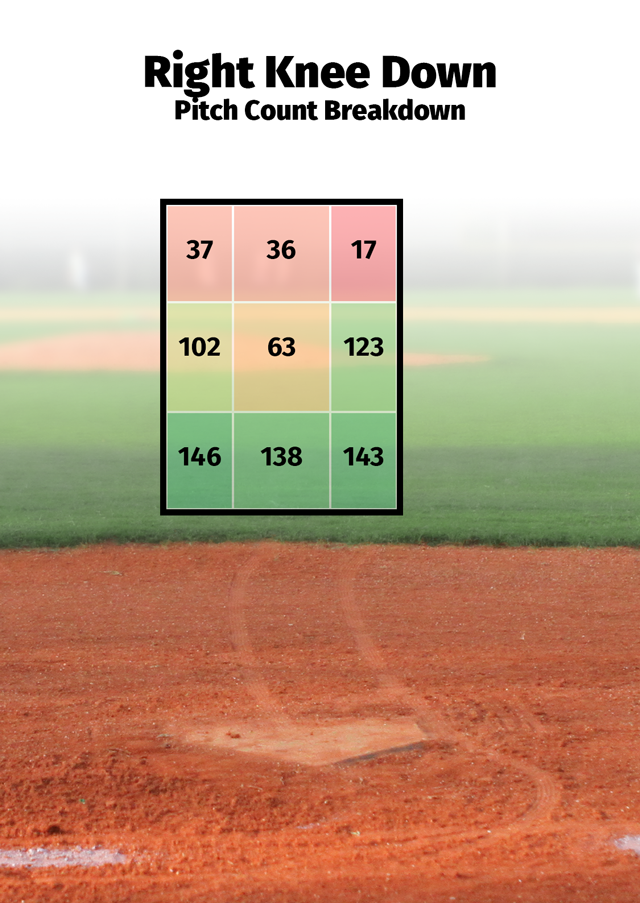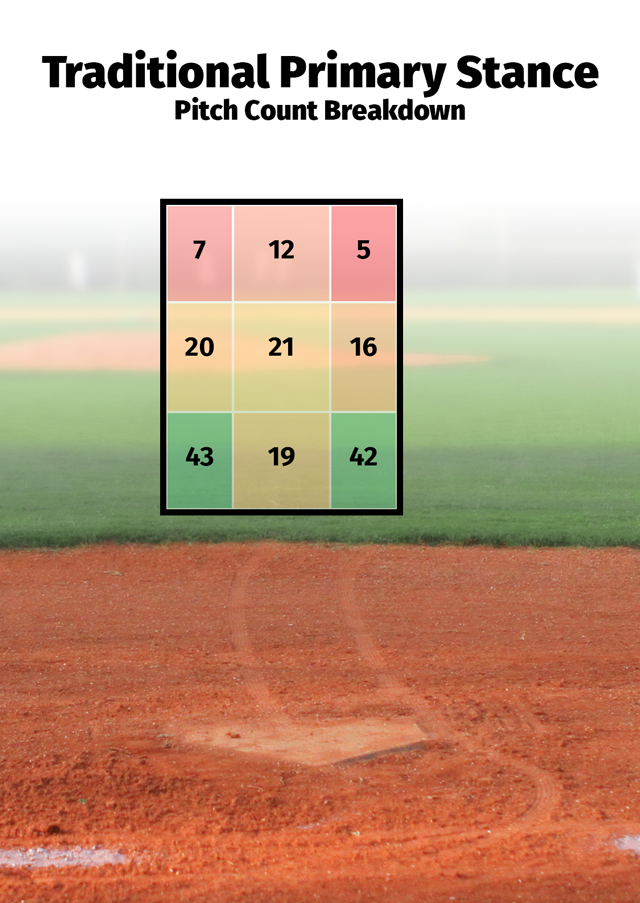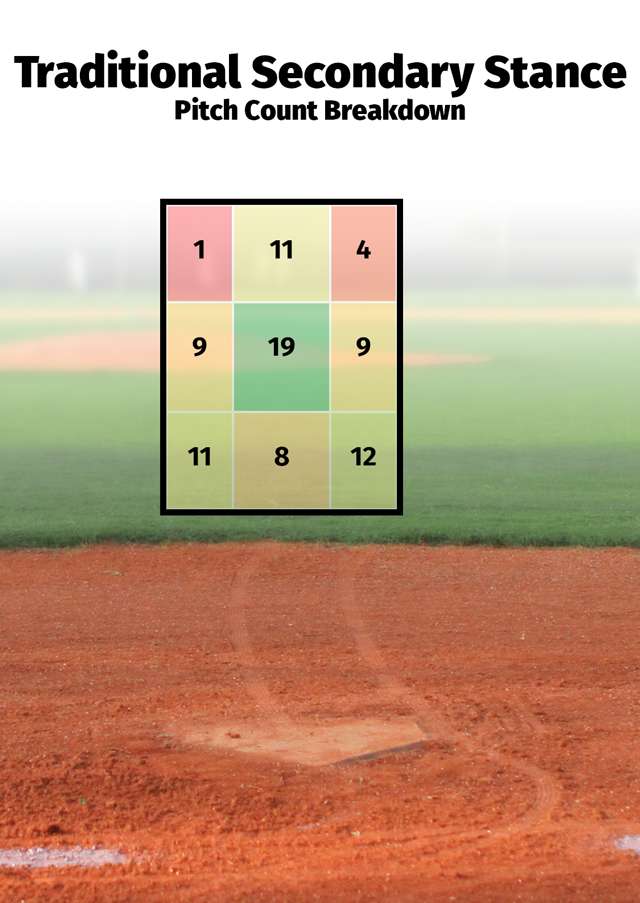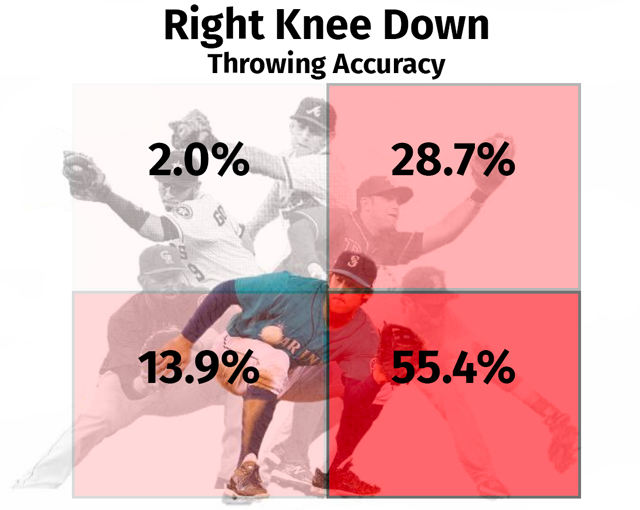Want more great
Catching Content?
Sign up for FREE and see everything we have to offer!
By now, I’m sure most people invested into the catching space are at least somewhat familiar with the one knee system Tanner Swanson implemented with Mitch Garver & the Minnesota Twins in 2019. He has since taken it to the Yankees as he was named the Major League Catching Director and Quality Control Coach.
After my buddy, Zac Stout, posted his case study on how the one knee system worked for his catchers in the fall, I was inspired to do a similar study with my Post Graduate & Varsity catchers at Inspiration Academy. Paul Rozzelle also shared the data from his catchers at Catawba Valley CC with me to include in the study.
Background Information
While the season was obviously shortened across the nation, between Paul and I’s catchers, I was able to collect close to 65-70 games worth of receiving, blocking, & throwing data as well numbers from charting bullpens & intersquad games. The study certainly wasn’t as extensive as I hoped it would be, but I still believe the data gives us some pretty strong conclusions. The stance guidelines I gave to my guys was what Mitch Garver did last year with the Twins which were:
- Left Knee Down Setup with RHH & no runners on base
- Right Knee Down Setup with LHH & no runners on base
- Right Knee Down Modified Kickstand with runners on base
With that being said, I did not force any of my catchers into strictly following these guidelines. All 7 of my catchers were given the same information and I allowed them to experiment with different setups and come to their own conclusions on what worked for them. A few of them followed the guidelines, a couple caught games entirely in a RKD modified kickstand while others still used more traditional primary and secondary setups.
Summary of Conclusions
In short, our catchers as a whole were better at receiving, blocking, & throwing using the 1 knee system rather than more traditional setups. I was able to calculate an estimate of framing, blocking, & throwing runs per game & split the numbers into runs per game from a knee down setup (either LKD or RKD) & the runs per game from more traditional primary & secondary setups.
You’ll see below that our catchers’ numbers suggest that they would prevent nearly a full run (.84) per game more from using one knee or knee down (KD) setups rather than traditional setups.
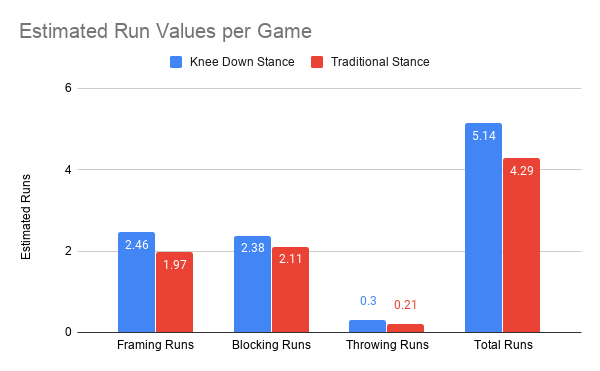
Because receiving is a catcher’s biggest chance to impact the game via run prevention, we want to get into our best receiving setups as much as possible, if not exclusively, and learn to block & throw from those setups. Compare that to an “old school” way of thinking where it’s simply one setup with no runners on base & a big active secondary stance with runners on base.
With that being said, every pitch that our catchers had a chance to “present” to the umpire (strikes & borderline pitches) was tracked by what setup the catcher was in & where the pitch was located. I created a heatmap for each setup with the data from all of our catchers and their successful reception rate in each zone. A successful reception was defined as a “presentable” pitch where our catcher presented the pitch well with no glove movement moving away from the zone. He didn’t drop the pitch, had no late glove/body movement, the presentation was smooth - not jerky, and the C was on time to the spot. Any reception not meeting this criteria was considered an “unsuccessful reception”. Note that the heatmaps below also include the borderline pitches in their corresponding locations, not just pitches in the zone. All heatmaps are from the catcher’s point of view.
Successful Reception Rate by Stance
Quantity of Pitches in Data Set
As you can see from the data presented above, the sample sizes from each setup are a bit widespread, but I think it paints a relevant picture nonetheless. The successful reception rate from either knee down setup was nearly identical, 89% on average, & allowed our catchers to optimize the strike zone, especially the bottom of the zone, which is generally where catchers have the most opportunities to add strikes. In the traditional primary, our catchers were still effective at optimizing the strike zone, but less so than in the one knee setups. In the traditional secondary, receiving takes a big hit. Especially with presenting pitches low in the zone which is ideally where we want to be our best at. Our catchers were 48% less successful on receiving pitches low in the zone.
The typical knock with using one knee setups with runners on base is that the one knee setup must limit your blocking ability. Similar to how Paul & I tracked receiving, we also tracked every ball in the dirt by setup & location with the successful block/pick rate defined as whether or not the runner advanced.
The data shows that as a whole our guys were 12% more successful at keeping runners from advancing on balls in the dirt from a one knee setup.
Blocking Success Rate
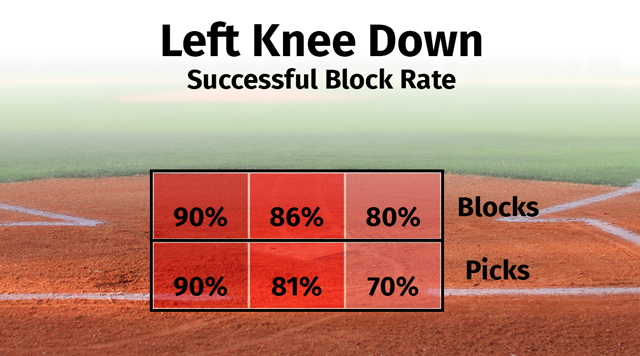
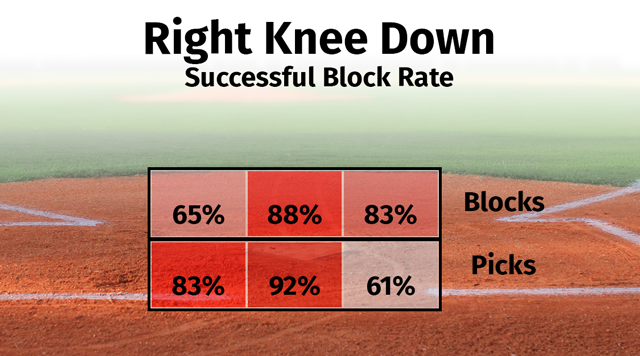
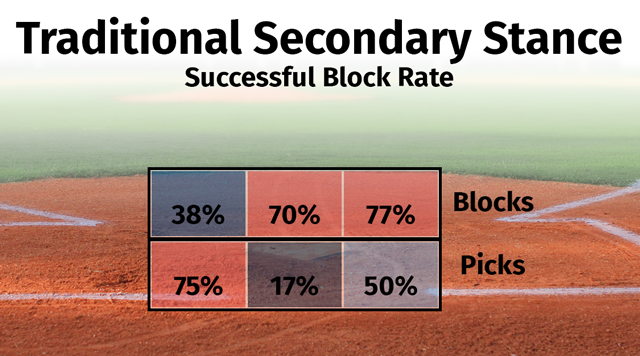
Quantity of Attempts in Data Set
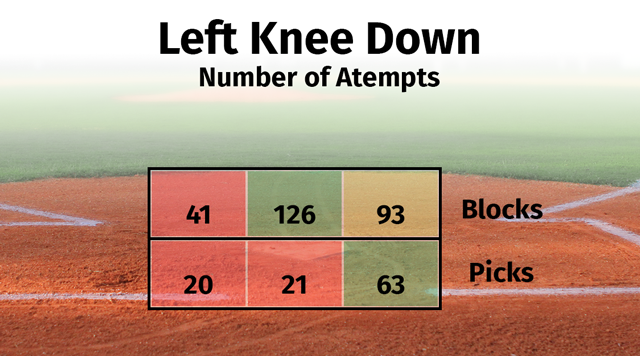
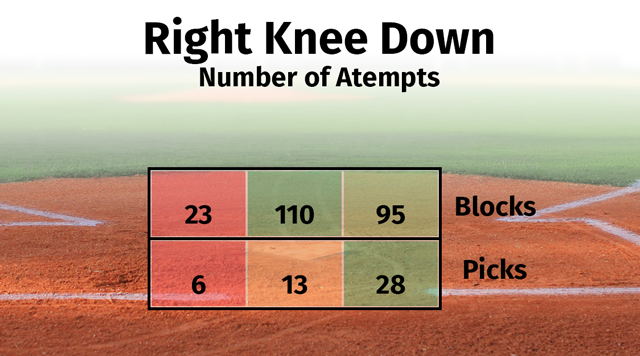
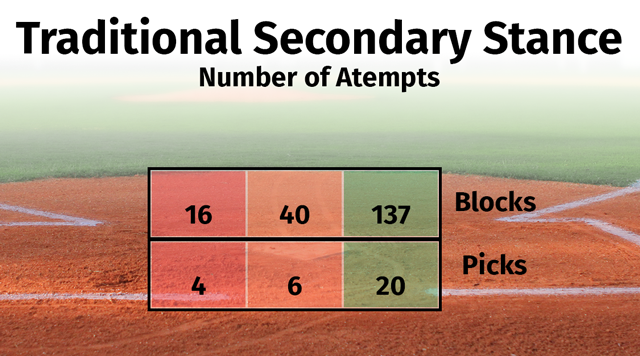
Similar to how the numbers came out with the receiving portion, the successful block rate was nearly identical from both the left knee down & right knee down setups at around 84%, while the block rate from a more traditional secondary stance fell to 72%. Our catchers were also more successful at picking balls in the dirt from a one knee setup at 76% from a LKD setup & 72% from a RKD setup. The pick rate fell to 47% from a traditional secondary.
In total, our catchers kept runners from advancing on balls in the dirt at a 77.4% success rate from either a LKD or RKD setup while the success rate from a traditional secondary setup was only 68.6%.
Another general concern of coaches is that our catchers are going to be slower throwing from a one knee setup than they would be from a traditional secondary stance. Generally, what I’ve found is that most catchers are about the same as far as release, pop time & accuracy of their throws. If not slightly better from the modified right knee down setup.
Here’s how each catcher fared in their average pop time from both the right knee down setup and the traditional secondary setup. (Note: I removed 2 of the catchers from this portion of the study as they had less than 10 throws recorded).

As you can see above, 9 of the 10 catchers had about the same or a quicker pop time from a right knee down set up than from a traditional secondary setup. I contribute most of this to the fact that throwing from the RKD setup really simplifies the footwork & exchange for most catchers. In a traditional secondary, most amateur catchers have the tendency to get jumpy and try to gain a ton of ground, whereas the RKD setup almost acts like a constraint to force catchers into getting closer to optimizing their footwork & exchange.
After analyzing the data on an individual basis, I combined the average of all the pop & release times from all 11 catchers to compare the numbers from the right knee down setup to the traditional secondary.
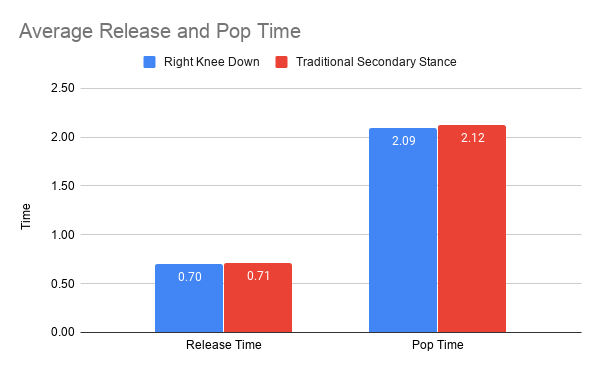
Lastly, catchers were graded from both setups on the accuracy of their throws to second base. 101 throws were made from the right knee down setups & 75 throws were made from the traditional secondary. The images below show how often our catchers hit each location from both setups.
From the data collected, we can conclude that on average, our catchers were slightly better in all aspects of throwing from the RKD setup versus the traditional secondary.
Conclusions
While I certainly believe that the one knee system has a ton of potential benefits for the general population of catchers, there are really no always’ or nevers’ in this game of baseball. Ultimately, if you’re looking to optimize your catcher’s impact behind the plate, you should approach their setups in 1 of 2 ways.
1. You find their best receiving setup(s), and help them learn to block & throw from those setups. It can be messy. It’s not always going to be the most comfortable thing at first, but you have to be willing to experiment and find what truly works for each catcher, communicate with your catchers, & constantly search for ways to improve.
2. You give your catcher a larger multitude of setups & guide them in figuring out which setups work best in certain situations. It’s not always going to be black & white. It may depend on what the most likely outcome of the pitch will be, & it will require communication & understanding from your catchers.
I hope this study helps provide some clarity, or at least sparks a deeper look into how you approach setups with your catchers.
Limitations of this Study
This study is by no means perfect. I didn’t have Trackman, a center field camera, or any other sort of pitch tracking technology. However, you don’t need all that stuff to at least get something started. I’ll attach the chart I used this year at the end. The charts were filled out during every game either by myself or by other catchers who weren’t playing at the time. Bullpens were charted using video and overlaying a strike zone on it. There is certainly some human error involved here, but regardless, I think the results still provide useful insight into how one-knee setups affect catcher performance.
Want more great
Catching Content?
Sign up for FREE and see everything we have to offer!

